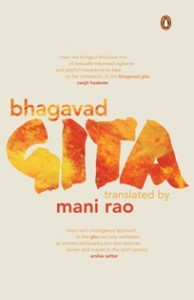 Gita is a text that has enchanted many since the time it was spoken at Kurukshetra. And it has enchanted each one in a unique way. What it says can be interpreted in so many ways. Depending on who is reading it, what the situation is, what the context is and what the time and space are. Anyone who reads it is bound to be in love with it. There are so many commentaries available on it that you can almost get lost in them. Careers of most of the spiritual gurus depend on how well are they able to talk about Gita to their audience.
Gita is a text that has enchanted many since the time it was spoken at Kurukshetra. And it has enchanted each one in a unique way. What it says can be interpreted in so many ways. Depending on who is reading it, what the situation is, what the context is and what the time and space are. Anyone who reads it is bound to be in love with it. There are so many commentaries available on it that you can almost get lost in them. Careers of most of the spiritual gurus depend on how well are they able to talk about Gita to their audience.
This Bhagavad Gita translation by Mani Rao belongs to this time and space. There are many interesting things about this translation. The most important being the fact that it is a poetic translation and not an interpretation. It follows the same chapters and verses as the original text. Though without stopping at the logical points. It goes on as one long poem. It does not get into explaining and interpreting. So you are free to draw your own meaning. It also reminds you that it is a song, a poetry… The name itself is Gita literally meaning the Song. A rhythm that is usually lost when reading or listening commentaries.
The language is contemporary or if I can say controlled colloquial and would find resonance with the Facebook generation. Though this does not mean that meaning or the depth of the text is compromised anywhere. There are words from the corporate world like teams and some inspired by the flowcharting language. At other places it gets mathematical and words are saved using the ‘=’ sign. I quite liked it as it helped avoid a lot of repetitions. The only place where I thought the language came in the way of the flow of words was the constant use of s/he, to mean both male and female. Being based in the west may have made it a compulsion to use this. But it took away that rhythmic flow of the poem. And was an eyesore as the text has been put in skillful designs in many places.
Then there are lots of words combined together as if they have been written in Sanskrit with a ‘sandhi’. You have to do your own ‘vichhed’ to separate the words. Most of these words have not been explained. And they just lie there in the middle of the verses, free-flowing and left for you to pick and interpret. At some place, the author has used her poetic license to use words like undependent.
I quite enjoyed reading this translation of Bhagavad Gita. Having said that I must admit that I have read Gita many times and in many versions, so I am not sure how it will be received by a first-time reader. In fact, I am curious to know what a first-time reader thinks of it. Read it for the poetic language that is not so usual these days…
Buy this book – Bhagavad Gita translated by Mani Rao at Amazon India.
Read more:






Nice posting, whenever I come across a blog that really has some excellent unique content I always want to say thank-you.